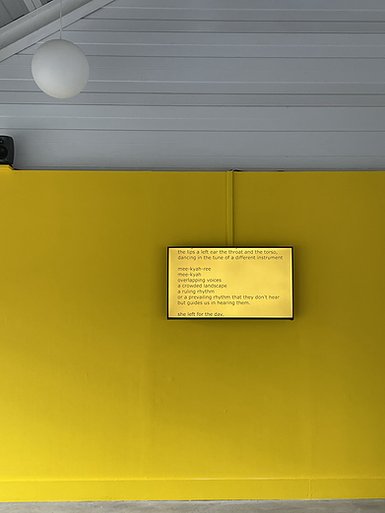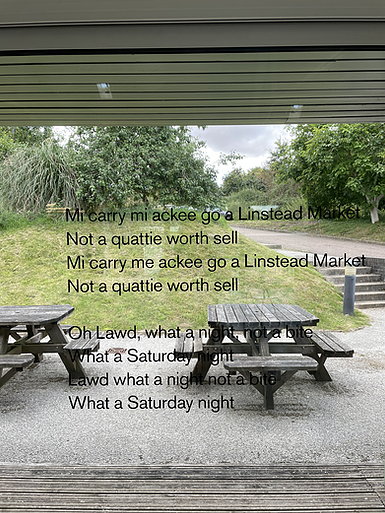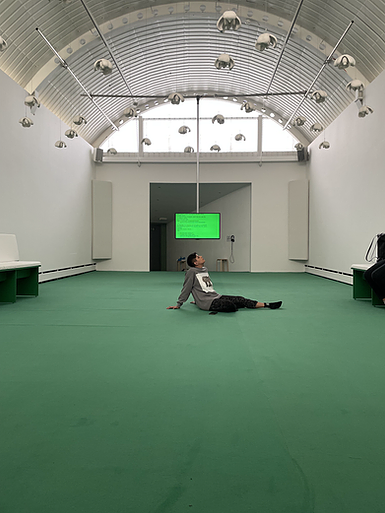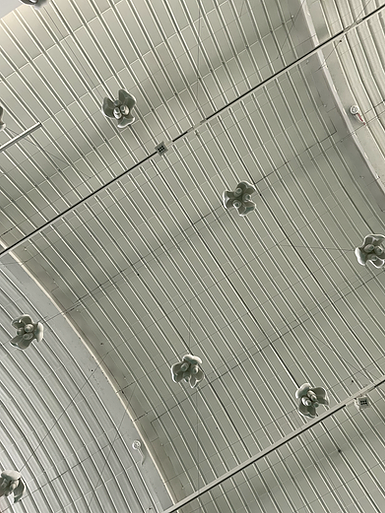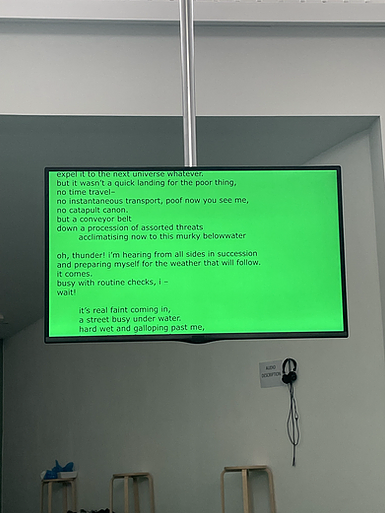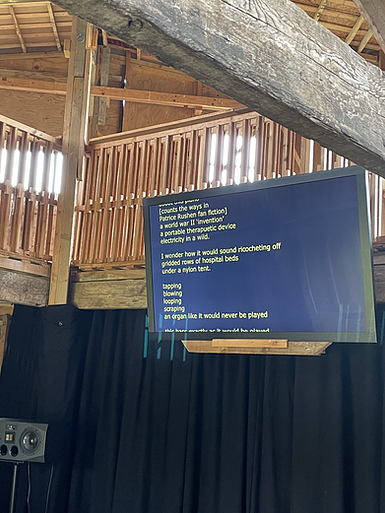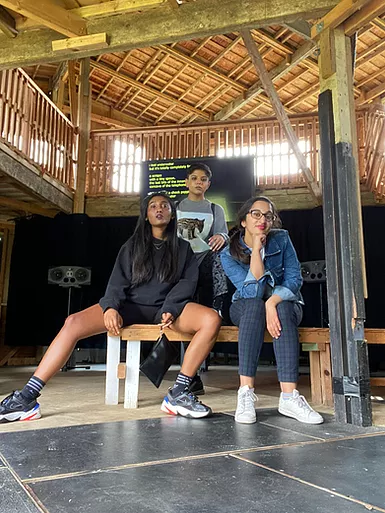Ain Bailey: Version @ Wysing Arts Centre
Emoji summary: 🪨🌼 🎧 🌀
The first room is the foyer of Wysing Arts Centre. The back wall is painted buttercup yellow, and there is a screen mounted on it, with text rolling on a buttercup yellow backdrop. There are song lyrics printed on the long window.
The second room is the main gallery, with the ramp up. There’s a felt-feel bottle green carpet, and the walls are clean and white. Little sculptures hang from the ceiling, ackee fruits, each slightly different. A screen hangs down, text rolling on bottle green.
The third room is the rickety shack out in the field behind the centre. Chunky speakers, benches. There’s a screen mounted up on the railed balcony, yellow text rolling across a black backdrop.
/////
I am unfortunate, because I’m completely unable to conceptualise sound. It is so foreign and abstract to me. I am amazed by musicians, DJs, by anyone who is able to organise sound or think about it in a linear way, because to me it is liquid chaos.
Throughout those three rooms, Ain Bailey has laid out a spread. For this review of Ain’s show, Version, at Wysing Arts Centre, I want to talk about generosity, overlap, and liquid.
/////
The first yellow room sounds raucous when I walk in. Voices and noises chime in over each other, like bells pealing, when they cascade in time, tumbling towards you. The voice is rough, chesty; there is a kind of raw ripping feeling to it, like when you raise your voice to the edge of a shout. And sighs from the throat, ragged, thumps - a body is moving, feeling and we are listening to the resonant sound of it. It separates out, or maybe I just settle into the rhythm of it. I can now pick out a single voice; Elaine Mitchener performing Linstead Market, a Jamaican folk song, and it is so sweet. It is music but it is also feeling and memory and history and maybe I am just a bit wet, but things like that always get me, so I feel a little tear in the corner of my eye, because Elaine’s voice is hitting me bang in the middle of my chest.
The second green room is filled with sound, demure and spacious. It is like a tingling, it booms and pops, crackles and sparkles at times too. This feels like sound that has moved from the chest to the fingers, toes. It is outer extremities, slender, agile. I think that description makes it sound cold, but it’s not. It is a kind of sizzling hot, but a low down contained sizzle. The sounds are Ain making ackee and saltfish. These sounds have been pulled up, treated as material, arranged and composed, stretched out on loop. The ackee fruit sculptures hanging from the ceiling are pendulums, and I lie on my back and look up at them. They were made by Martha Todd, and I play spot the difference, imagine them swinging, swaying gently in the breeze.
The third room, out in the lil rickety shack is like a contained theatre. Like old school Polly Pockets, where there’s a whole compact world that can fold right out of a hard plastic handbag. Ain has used 3 tracks made by Matthew Ritson, for the bassline in this room, blended them into a bigger composition and made an homage to dub. The sounds are heavy, slapping, continuous; a rolling bass that comes at you like waves. The pops over top are heavier now, they tick over like they’re moving, and they’re laced with a kind of crackling that glitters with meaty thickness. The sounds are the world, full on the inside, folding out. I sit on the bench feeling like I am in a bathtub, like I am floating in something. The sound has a different quality, like it is shifting in front of me, or like it is a collection of single units that interchange and come together, only to drift back apart. Like a bike chain rolling over that spiky little wheel, many moving parts as one.
/////
Throughout these 3 rooms, there is a text accompanying the sound, rolling over the screens like end credits. They are translations, written by Taylor Le Melle. Taylor offers an interpretation, conversation, likeness. The little description of the show explains that the text translations are ‘part of an exploration of how sound works can be made more accessible for D/deaf audiences’. It feels like a meta-zoom-out from myself; I often think about how I want to describe an artwork to you (the reader) in these reviews. How do I describe what’s in the room, what language do I use to convey, and how do I approach building the scene of what I experienced in the gallery? How much do I add or lose by transferring to text? I think rendering an artwork as text is a weird and unstable kind of production; you’re half-making something that runs parallel or orbits that artwork, but something has been spirited into being all the same. That parallel production of artwork-rendered-as-text sits somewhere alongside fan fiction, tribute act, parody (as well as translation or interpretation). This instability is exciting, and it makes me feel like a kind of magician, able to pull sleight of hand and showmanship into it all.
I don’t know what Taylor’s writing process looked like for these texts, but I can imagine them at a table, with headphones on and eyes closed, typing like a conductor, like sound was just flowing from their ears straight down to their fingertips. Like possession or like body-brain-word daisy chain. I can also imagine a painstaking process, Taylor pacing a room with a printout in hand, scratching out lines and reworking them so they’re perfect. But maybe also something accumulative! Returning every time a thought pops up, letting thoughts drift in and out, waking up in the middle of the night to write down a line before it dissolves back into that dreamy haze. Or iterative: approaching an idea from multiple possible angles, trying on likeness in the hopes that taking a few run ups at description will build a more accurate scene through simile. Ahhhh, maybe there’s an aspect of fiction to it? Something is built there - maybe it is story, maybe it is a scene.
/////
I think Version is a display of generosity, because it is sound as a material laid up against other things that make it more accessible (I mean accessible in many possible ways). If sound is a chaotic liquid, or language I’m not fluent in, then sculpture, text and scene-setting are offered out to me as a guiding hand to help me on my way. If sound is something I struggle to grab onto, this is a generous way for me to engage with it. I am glad that Ain has taken the time to figure out where the limits of the sound she’s wrangling with might be, figure out how to extend those limits further, and do so by pulling other makers in. Extending out in that way is nothing but pure generosity, because it is building a space that is as full as possible. In that fullness, careful - it extends itself as possibility, to peel away as I need, want, or would like. It offers a word I have been avoiding for the length of this entire review, bc maybe deploying it as a descriptor here would be a trite punchline. But: versions.
Ain Bailey's show, Version, was on at Wysing Arts Centre until 22nd August, but you can have a peep at the documentation here.
